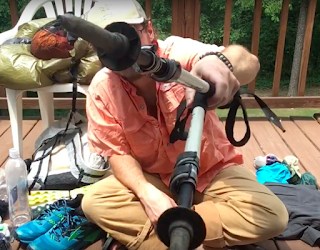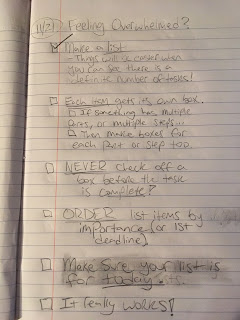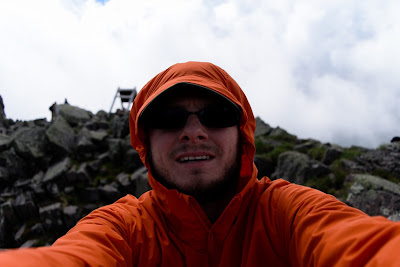The Case for Trekking Poles - why I use them
Both new and long-time hikers often have the same questions, "Why use trekking poles? Do they really help?"
I had a flattering commenter ask about trekking poles on one of my most recent videos, and I would like to share my reply here with you in case you have been wondering yourself.
I really appreciate that Travis. The case for Trekking poles, or a single Walking stick even, is simply that more points of contact means more safety for things like slippery conditions on wet rock or mud and especially for stream crossings where you are trying to balance on logs or rock-hop across without getting your feet wet. When wading across unexpectedly larger streams and creeks during heavy rains I’d say a hiking staff or trekking poles are an absolute necessity from a safety standpoint.
Now, you can grab a stick for a stream crossing and use it as you would a wading staff. The advantage you have with your equipment though is that you have something purpose-built and tough enough to handle the stress of using it for balance whereas a stick that looks strong enough to hold your weight could easily snap on you when you lose your balance in a creek.All that aside, I’ve done serious miles with and without poles. I can’t tell you how much I miss my poles on long hiking days. The craziest thing that I have noticed is that my calves will burn so badly on uphills that sometimes I have to slow down or keep hiking with an incredible tightness in them. For whatever reason, whether it be a change in posture/balance or the added pushing of my arms through the poles, my legs do not burn on big uphills when I use poles (when in good shape lol).
I remember how stupid I felt using the poles and not knowing if they even made a difference when I got my first poles and set out hiking from Springer Mountain on the AT for the first time. I didn’t know when to jab them down or how exactly to use them while walking. It just felt like they were useful for getting around and over obstacles, and I didn’t really get why people would hike over normal terrain with them.Within the first 200 miles they absolutely did become an extension of my body. I would slip in some mud that I didn’t notice, or maybe trip on a little protruding rock, and I would catch myself with my poles reflexively.
The best example of this was in the White Mountains in New Hampshire. The rocks were wet and I went to step down to another boulder on a downhill climb, I slipped, and I fell forwards into what would have been at least a very painful fall (probably would have taken me off trail). Instead of getting hurt my trekking poles shot forward before I could even think of it and my carbide pole tips dug into the rock I was falling towards, caught my full weight, and saved me. The muscle-memory and reflexes you build with gear that you use frequently makes their use automatic. It’s awesome. Now, when I’m on flat ground and moseying down a nice, dry trail I will sometimes hold my poles in one hand and not use them for a while. It’s not a terrible thing to have to hold them. Sometimes I’d put them away on the side of my pack if I was on a road-walk into town or walking through big, open fields.When I slipped in the rain and hurt my knee (fall after 44:00) on the last 600 mile stretch to finish the AT, within an hour the inflammation was so bad that I was putting a lot of weight on my poles to keep my weight off of the hurt knee and slowly I realized I hurt myself way worse than I thought). That walk into town, and the next two weeks of hiking, would’ve been awful without them.I also use them with my poncho tarp shelter. [Having two adjustable trekking poles makes setting up tarps very easy.]
And as a last note, when I’m walking alone in the woods I sometimes feel like it’s just nice to have something in my hands. If my hands hang down at my sides all day I can feel the blood pooling in my fingers. When my hands are empty and have nothing to do I end up picking up sticks and breaking them or fiddling with something and it’s almost like I feel like it’s easier to get bored when my hands aren’t engaged in a task.I almost even feel a little naked, like if some kind of animal came at me I wouldn’t have something to throw at it or fend it off with.
There is a video of a hiker where he talks about having just been charged by a grizzly and that he threw his trekking pole at it like a spear and it took off running away from him (Andrew Skurka https://youtu.be/jtsI1DOlVow ). I’m not saying that would work again or work for anyone else, but it’s a feeling.
That’s the full spread on why I will keep using them, though I’ll admit on my last overnighting video I didn’t bring them with me. A stick broke on a stream crossing in that video and my buddy almost fell [in a really bad spot].
My poles need some serious maintenance after two years of hard use, right now they are hard to collapse and the closures are all rusted. I am thinking that some WD-40 and a wire brush will do the job.I hope that that is helpful. I might have to turn this comment into a video in the future.Thank you for your comment, compliment, and support of the channel Travis. :)
-----
Travis was happy with the reply! I hope you got something out of it as well if you are trying to decide whether or not to purchase a pair of poles.







Comments
Post a Comment
Hey, I appreciate you taking the time to comment. I hope you have a really good day.